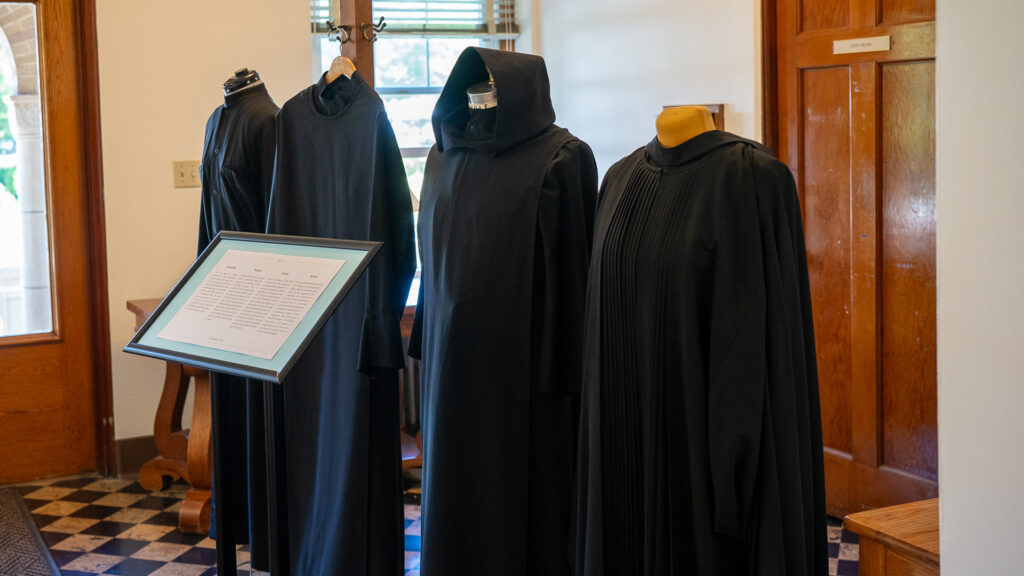Breaking Down the Habit

“I’m sorry, I have to ask, what are you?” This question, posed to four of us monks wearing habits in the Salem Hospital elevator while visiting a sick confrere, reminded me how distinct religious clothing is. Not simply long black robes, hoods, and sandals, however, monastic clothing is an external sign of an ongoing interior conversion. While the initial reasons for some decisions made about monastic clothing have become obscure as the centuries have passed, the larger themes of unity and self-sacrifice have endured. St. Benedict devotes just one brief section to “the clothing and the footwear of the brothers,” chapter 55 of the Rule, but, like the rest of the Rule, much can be gleaned by a closer reading of this section.
The balance and discretion characteristic of St. Benedict is particularly evident when he writes, “The clothing distributed to the brothers should vary according to the local conditions and climate because more is needed in cold regions and less in warmer. This is left to the abbot’s discretion” (RB 55:1-3). With Benedictine monasteries currently established on the six major continents, this provision shows great foresight by someone writing in 6th century Italy. The garments St. Benedict lists for monks in this chapter are a tunic, cowl, scapular, shoes, and sandals; he prescribes monks to have two of these “to provide for laundering and night wear” (RB 55:10). Monks today wear these same garments.
Monks receive different articles of the habit as they progress through formation at Mount Angel. Postulants entering the monastery receive a belt and a tunic. The belt is traditionally associated with the virtue of chastity and girding one’s loins. In continuing to the novitiate, monks are invested with the scapular, which is blessed by the abbot in a short rite preceding Vespers. Monks making their simple vows after completing the novitiate receive a hooded scapular. Monastic hoods are often raised while praying or reading Scripture, but also during the funeral procession of a monk. After simple vows, monks making their solemn profession receive the cuculla, a traditional choir robe typically worn on Sundays and solemnities. There is no distinctively clerical part of the habit today; solemnly professed priests and brothers at Mount Angel wear the same habit.
As clothing trends change rapidly in society, there is a certain timeless quality to monastic garb. The black color of the tunic and scapular is a reminder that the monk has died to the world and that he now lives a life hidden in Christ (Colossians 3:3). The tunic may not have had particular significance when St. Benedict prescribed its use, but likely was commonly worn during his lifetime. The scapular, a rectangular piece of cloth that resembles a cape and apron, was a work garment that helped keep the tunic clean for liturgical use. Today, however, monks engaged in manual labor remove their habit and wear contemporary work clothing to keep their tunic and scapular clean. St. Benedict says that monks should have both shoes and sandals (RB 55:6). Presumably shoes would be worn for manual labor and in the colder winter months. Both shoes and sandals are worn by modern monks, with an emphasis on simplicity.
The Benedictine habit is simple, devoid of the ubiquitous branding seen today. St. Benedict writes that, “Monks must not complain about the color or coarseness of all these articles, but use what is available in the vicinity at a reasonable cost. However, the abbot ought to be concerned about the measurements of these garments that they not be too short but fitted to the wearers” (RB 55:7-8). Mount Angel monks are fitted for their habits before beginning as postulants and are mended as needed. In a world frequently focused on customization and individual taste, monks inherit the habit, rather than designing their own. Seeing habit-wearing monks reminds Abbey visitors that they, and the larger world, are being prayed for constantly. It also reminds the monks that “nothing is to be preferred to the work of God” (RB 43:3) and that “[our] way of acting should be different from the world’s way; the love of Christ must come before all else” (RB 4:20-21). The habited monk is “putting on the Lord Jesus Christ” (Romans 13:14) and must pray that his thoughts and deeds are in accord with the will of God.
—Br. Alexander Delsman
Categories: Monastery
